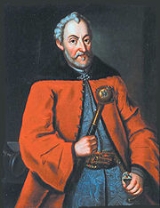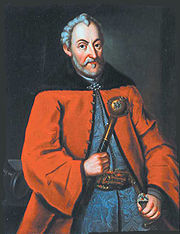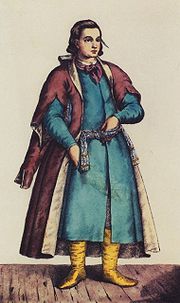
Zupan
Encyclopedia

Polish-Lithuanian Commonwealth
The Polish–Lithuanian Commonwealth was a dualistic state of Poland and Lithuania ruled by a common monarch. It was the largest and one of the most populous countries of 16th- and 17th‑century Europe with some and a multi-ethnic population of 11 million at its peak in the early 17th century...
, typical male attire from the beginning of the 16th to half of the 18th century, still surviving as a part of the Polishnational dress.
Derivation
The name żupan has other spelling variations — czupan (from czupkan, a Crimean TatarCrimean Tatar language
The Crimean Tatar language is the language of the Crimean Tatars. It is a Turkic language spoken in Crimea, Central Asia , and the Crimean Tatar diasporas in Turkey, Romania, Bulgaria...
word or alternatively from zuban or ziban — a Turkish
Turkish language
Turkish is a language spoken as a native language by over 83 million people worldwide, making it the most commonly spoken of the Turkic languages. Its speakers are located predominantly in Turkey and Northern Cyprus with smaller groups in Iraq, Greece, Bulgaria, the Republic of Macedonia, Kosovo,...
word according to Julian Horoszkiewicz), and etymologically related to the Central Asian chapan
Chapan
Chapan is a coat worn over clothes, usually during the cold winter months. Usually worn by men, these coats are adorned with intricate threading and come in a variety of colors and patterns. It is worn in Central Asia, including Uzbekistan, Afghanistan, Tajikistan, Kazakhstan, Kyrgyzstan and other...
. Alternatively, the name originates from the Italian word giuppa (gown) which in turn might have come from Arabic (jubba
Jubba
Jubba is a Persian and South Asian ankle-length garment, usually with long sleeves, and similar to a robe. It is synonymous to the thawb....
), although the garment itself probably is of Central Asia
Central Asia
Central Asia is a core region of the Asian continent from the Caspian Sea in the west, China in the east, Afghanistan in the south, and Russia in the north...
n nomad
Nomad
Nomadic people , commonly known as itinerants in modern-day contexts, are communities of people who move from one place to another, rather than settling permanently in one location. There are an estimated 30-40 million nomads in the world. Many cultures have traditionally been nomadic, but...
ic origin. Whether the garment came from Central Asia or Ottoman Turkey or Iran
Iran
Iran , officially the Islamic Republic of Iran , is a country in Southern and Western Asia. The name "Iran" has been in use natively since the Sassanian era and came into use internationally in 1935, before which the country was known to the Western world as Persia...
still remains a question, and the same applies to the allied male garment — the kontusz
Kontusz
Kontusz - a type of outer garment worn by the Hungarian, Polish, Belarusian, Lithuanian and Ukrainian male nobility...
. The Central Asian origin of this garment may be also deduced from the method of closure of the pre-1680s zupans, for they were closed from right to left — a typical Eastern (Central Asian) fashion, while the sleeve-ends terminated with dog-ears that were almost like gloves without covering the fingers, and were usually upturned to show the differently colored lining. Eventually an agraffe
Agraffe
An agraffe is a part found on some pianos. The agraffe is a guide at the tuning-pin end of the string, screwed into the plate, with holes through which the strings pass. It anchors the strings, ensures proper height and determines the speaking length of the string. Quality agraffes are usually made...
(clasp
Fastener
A fastener is a hardware device that mechanically joins or affixes two or more objects together.Fasteners can also be used to close a container such as a bag, a box, or an envelope; or they may involve keeping together the sides of an opening of flexible material, attaching a lid to a container,...
) or button was attached to this dog-ear sleeve-end to pin it to a sleeve once upturned and thus a cuff
Cuff
A cuff is an extra layer of fabric at the lower edge of the sleeve of a garment covering the arms. In US usage the word may also refer to the end of the leg of a pair of trousers...
was created. This style of cuff was known in the Louis XIV period in France
France
The French Republic , The French Republic , The French Republic , (commonly known as France , is a unitary semi-presidential republic in Western Europe with several overseas territories and islands located on other continents and in the Indian, Pacific, and Atlantic oceans. Metropolitan France...
as the Polish cuff and might have led to the development of colorful military cuffs used in Western armies from 18th century onwards.

The Ruin
"The Ruin" is an 8th-century Old English poem from the Exeter Book by an unknown author. The Exeter Book is a large book of mostly Christian verse, which contains about one-third of the extant Old English poems...
), the inhabitants of Left Bank Ukraine continued to wear żupan, the name transliterated into , and also adopted the kontusz from their Right Bank counterparts as part of their dress, and therefore żupan was worn by Ukrainian nobility, wealthy merchants, cossacks, wealthier peasants and town dwellers as well as new Russian inhabitants - administrators, soldiers, and settlers. Żupan, along with kontusz, was worn also in Russia, especially during the second half of the 17th century, when Polish male costume became popular at the Imperial court.
Development
During the course of the 16th century the żupan was a popular male costume worn in lands ruled by the Polish KingdomKingdom of Poland (1385–1569)
The Kingdom of Poland of the Jagiellons was the Polish state created by the accession of Jogaila , Grand Duke of Lithuania, to the Polish throne in 1386. The Union of Krewo or Krėva Act, united Poland and Lithuania under the rule of a single monarch...
and Grand Duchy of Lithuania
Grand Duchy of Lithuania
The Grand Duchy of Lithuania was a European state from the 12th /13th century until 1569 and then as a constituent part of Polish-Lithuanian Commonwealth until 1791 when Constitution of May 3, 1791 abolished it in favor of unitary state. It was founded by the Lithuanians, one of the polytheistic...
(after 1569 the Polish-Lithuanian Commonwealth
Polish-Lithuanian Commonwealth
The Polish–Lithuanian Commonwealth was a dualistic state of Poland and Lithuania ruled by a common monarch. It was the largest and one of the most populous countries of 16th- and 17th‑century Europe with some and a multi-ethnic population of 11 million at its peak in the early 17th century...
). It was worn by males of all social classess, although the most expensive and colorful textile
Textile
A textile or cloth is a flexible woven material consisting of a network of natural or artificial fibres often referred to as thread or yarn. Yarn is produced by spinning raw fibres of wool, flax, cotton, or other material to produce long strands...
s were used only by the nobility szlachta
Szlachta
The szlachta was a legally privileged noble class with origins in the Kingdom of Poland. It gained considerable institutional privileges during the 1333-1370 reign of Casimir the Great. In 1413, following a series of tentative personal unions between the Grand Duchy of Lithuania and the Kingdom of...
while other social classes were restricted in color and richness of textiles due to legal restrictions and/or expense costs.
The first mention of żupan appeared in 1393 but it was only gradually adopted as national male garment, first by nobility and later by other social classes, during the course of the 16th century. It was a long robe-like garment, always opened in the front, with long sleeves and a row of buttons (later very often decorative buttons called guzy) and since the 1570s, also a collar. This basic design did not change much but for the size and cut of the collar and type of fabric. Until the 1660s the collars were high, then gradually they became lower and with open, rounded corners. Also at first Żupan served as outer garment made from sturdy cloth or wool and often lined with fur and worn with a belt from which, in the case of nobility, a sword was hung. It was worn underneath the typical outer garments like bekiesza
Bekiesza
Bekiesza is a village in the administrative district of Gmina Cyców, within Łęczna County, Lublin Voivodeship, in eastern Poland. It lies approximately east of Cyców, east of Łęczna, and east of the regional capital Lublin.-References:...
, delia, ferezja, szuba and burka
Burqa
A burqa is an enveloping outer garment worn by women in some Islamic religion to cover their bodies in public places. The burqa is usually understood to be the woman's loose body-covering , plus the head-covering , plus the face-veil .-Etymology:A speculative and unattested etymology...
by nobility and wealthier people like merchants. Only gradually it became a lighter garment to be worn underneath the kontusz
Kontusz
Kontusz - a type of outer garment worn by the Hungarian, Polish, Belarusian, Lithuanian and Ukrainian male nobility...
, while the belt became a colourful affair worn over the kontusz. In case of the poor nobility members and lower social classes it remained the outer garment until its demise, while wealthier burgher
Bourgeoisie
In sociology and political science, bourgeoisie describes a range of groups across history. In the Western world, between the late 18th century and the present day, the bourgeoisie is a social class "characterized by their ownership of capital and their related culture." A member of the...
s would use it as a inner garment along with kontusz and other outer garments in the fashion of nobility.
In Polish military use the żupan served as the outer garment worn on its own by both cavalry and infantry. In the case of heavy cavalry (Polish hussars
Polish Hussars
The Polish Hussars were the main type of cavalry of the first Polish Army, later also introduced into the Army of the Grand Duchy of Lithuania, between the 16th and 18th centuries...
) and medium cavalry (pancerni) it was worn immediately beneath armour. There was also a padded version after the Central Asian traditions and it then might be called an arming coat, (there is an example of padded żupan in the Polish Army Museum
Polish Army Museum
-Newest Exhibition:The Polish Army Museum was not too long ago given the equipment of the lost soldiers from the Presidential Smolensk aircraft crash. The equipment includes the ID Passes, Portable radios, torches, holsters and much more and all in their original state.Museum of the Polish Army is...
). Żupan was often used in its shorter cavalry version, known as the żupanik.
After 1680s, the żupan was typically worn beneath a kontusz
Kontusz
Kontusz - a type of outer garment worn by the Hungarian, Polish, Belarusian, Lithuanian and Ukrainian male nobility...
and in such union those two garments became the typical attire for Ukrainian cossacks as well as the Polish national costume until the mid-19th century.
Make-up
Żupans were made of many fabrics as were available to the szlachtaSzlachta
The szlachta was a legally privileged noble class with origins in the Kingdom of Poland. It gained considerable institutional privileges during the 1333-1370 reign of Casimir the Great. In 1413, following a series of tentative personal unions between the Grand Duchy of Lithuania and the Kingdom of...
or the lower classes. Magnate
Magnate
Magnate, from the Late Latin magnas, a great man, itself from Latin magnus 'great', designates a noble or other man in a high social position, by birth, wealth or other qualities...
s generally wore żupans sporting golden or jewelled buttons, and tailored from the most expensive fabrics of their times such as the very expensive Persian fabric known as crimson
Crimson
Crimson is a strong, bright, deep red color. It is originally the color of the dye produced from a scale insect, Kermes vermilio, but the name is now also used as a generic term for those slightly bluish-red colors that are between red and rose; besides crimson itself, these colors include...
, which won their wearers the name, karmazyni or "crimson men", then from various expensive silk
Silk
Silk is a natural protein fiber, some forms of which can be woven into textiles. The best-known type of silk is obtained from the cocoons of the larvae of the mulberry silkworm Bombyx mori reared in captivity...
based fabrics like satins, brocades and damascs. Richer szlachta
Szlachta
The szlachta was a legally privileged noble class with origins in the Kingdom of Poland. It gained considerable institutional privileges during the 1333-1370 reign of Casimir the Great. In 1413, following a series of tentative personal unions between the Grand Duchy of Lithuania and the Kingdom of...
emulated the magnates with cheaper versions of silk-and-linen fabrics while the lower levels of szlachta
Szlachta
The szlachta was a legally privileged noble class with origins in the Kingdom of Poland. It gained considerable institutional privileges during the 1333-1370 reign of Casimir the Great. In 1413, following a series of tentative personal unions between the Grand Duchy of Lithuania and the Kingdom of...
usually wore żupans made out of cheaper white linen (summer) or duller in colour varieties of wool
Wool
Wool is the textile fiber obtained from sheep and certain other animals, including cashmere from goats, mohair from goats, qiviut from muskoxen, vicuña, alpaca, camel from animals in the camel family, and angora from rabbits....
(winter), hence their nickname, szaraczkowie — "grey men". Colors of Żupan varied, however the lining was always of a different color than the outer fabric.
Other social classes tried to emulate the szlachta. Poorer townsfolk often wore yellowish żupans made from hemp
Hemp
Hemp is mostly used as a name for low tetrahydrocannabinol strains of the plant Cannabis sativa, of fiber and/or oilseed varieties. In modern times, hemp has been used for industrial purposes including paper, textiles, biodegradable plastics, construction, health food and fuel with modest...
, which resulted in them being nicknamed łyczki. Polish Jews wore black żupans, and peasants wore simple, white (summer) and greyish (winter) żupans from wool or simple cloth.
In 18th-century Poland
Poland
Poland , officially the Republic of Poland , is a country in Central Europe bordered by Germany to the west; the Czech Republic and Slovakia to the south; Ukraine, Belarus and Lithuania to the east; and the Baltic Sea and Kaliningrad Oblast, a Russian exclave, to the north...
, the żupan became even lighter, with long and narrow sleeves, while the unseen back was tailored from some inexpensive fabrics such as linen or cotton. It then assumed its final version (when worn with the kontusz and wide, colourful fabric belt) and survived into the 19th century as a part of the Polish "national dress" — integral to regional male costumes, including those of peasants.
Use of the żupan finally started to decline in the 19th century with the coming of the modern western male dress, but the holiday regional peasant costumes in Poland still have zupans as part of their attire. Currently, and for the last 20 years, many reenactment groups in Poland, Belarus, Ukraine, Lithuania, and the USA have been reconstructing and wearing zupans during their shows and gatherings, e.g. Vivat Vasa, Choragiew Jakuba Wejhera or Chorągiew Husarska marszałka Woj. Pomorskiego.

